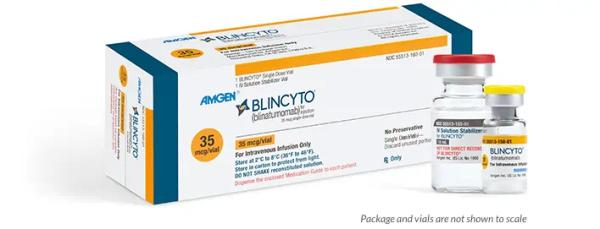Blinatumomab Disease Interactions
There are 8 disease interactions with blinatumomab.
- Vaccination
- Leukoencephalopathy
- Liver dysfunction
- Metabolic acidosis
- Neurologic disorders
- Neutropenia
- Pancreatitis
- Renal impairment
Blinatumomab (applies to blinatumomab) vaccination
Major Potential Hazard, Moderate plausibility.
The administration of live vaccines should be avoided during therapy with blinatumomab. Vaccination with live virus vaccines is not recommended for at least 2 weeks prior to start of therapy, during treatment, and until the immune system has recovered following last cycle of blinatumomab. It is recommended to be up-to-date with all required immunizations, as recommended by current immunization guidelines, before initiating therapy.
Blinatumomab (applies to blinatumomab) leukoencephalopathy
Moderate Potential Hazard, Moderate plausibility. Applicable conditions: History - Radiation Therapy
Cranial MRI changes showing leukoencephalopathy have been observed in patients receiving blinatumomab, especially in patients with prior treatment with cranial irradiation and antileukemic chemotherapy (including systemic high-dose methotrexate or intrathecal cytarabine). The clinical significance of these imaging changes is unknown.
Blinatumomab (applies to blinatumomab) liver dysfunction
Moderate Potential Hazard, Moderate plausibility. Applicable conditions: Liver Disease
No formal pharmacokinetic studies have been conducted in patients with hepatic impairment. Data has indicated that there are no clinically significant differences in exposure to blinatumomab based on mild or moderate hepatic impairment.
Blinatumomab (applies to blinatumomab) metabolic acidosis
Moderate Potential Hazard, Moderate plausibility. Applicable conditions: Prematurity/Underweight in Infancy
Some formulations of blinatumomab contain benzyl alcohol (a preservative). Pediatric patients with immature pathways for alcohol metabolism or with underlying conditions that could predispose to acid base imbalance may be at risk for serious adverse reactions, including fatal reactions and the "gasping syndrome". Early preterm very low birth weight neonates (less than 1500 g) may be at higher risk. Use the preservative-free preparations of blinatumomab where possible in neonates and consider the combined daily metabolic load of benzyl alcohol from all sources. Monitor neonatal patients receiving blinatumomab with preservative for new or worsening metabolic acidosis.
Blinatumomab (applies to blinatumomab) neurologic disorders
Moderate Potential Hazard, Moderate plausibility.
Blinatumomab may cause serious or life-threatening neurologic toxicity, including immune effector cell-associated neurotoxicity syndrome. There is limited experience with blinatumomab in patients with active acute lymphoblastic leukemia in the CNS or a history of neurologic events. Patients with a history or presence of clinically relevant CNS pathology were excluded from clinical studies.
Blinatumomab (applies to blinatumomab) neutropenia
Moderate Potential Hazard, Moderate plausibility.
The use of blinatumomab may cause life-threatening neutropenia, and febrile neutropenia. It is recommended to monitor complete blood counts during the infusion. Therapy interruption is recommended for prolonged neutropenia. Care and close monitoring is recommended, in particular for any episodes of fever.
Blinatumomab (applies to blinatumomab) pancreatitis
Moderate Potential Hazard, Moderate plausibility.
Fatal pancreatitis has been observed in patients treated with blinatumomab in combination with dexamethasone. Care should be exercised when using blinatumomab in combination with dexamethasone in patients with pancreatic disorders. Management of pancreatitis may require either temporary interruption or discontinuation of these agents.
Blinatumomab (applies to blinatumomab) renal impairment
Minor Potential Hazard, Moderate plausibility. Applicable conditions: Renal Dysfunction
No formal pharmacokinetic (PK) studies of blinatumomab have been conducted in patients with renal impairment. There is no data available in patients with severe renal impairment (CrCl 15 to 29 mL/min) or in patients on hemodialysis. PK analyses in patients with moderate renal impairment (CrCl 30 to 59 mL/min) determined blinatumomab clearance to be essentially within the range observed in patients with normal renal function.
Switch to professional interaction data
Blinatumomab drug interactions
There are 278 drug interactions with blinatumomab.
More about blinatumomab
- blinatumomab consumer information
- Check interactions
- Compare alternatives
- Reviews (2)
- Side effects
- Dosage information
- During pregnancy
- Drug class: bispecific T-cell engagers (BiTE)
- Breastfeeding
- En español
Related treatment guides
Drug Interaction Classification
| Highly clinically significant. Avoid combinations; the risk of the interaction outweighs the benefit. | |
| Moderately clinically significant. Usually avoid combinations; use it only under special circumstances. | |
| Minimally clinically significant. Minimize risk; assess risk and consider an alternative drug, take steps to circumvent the interaction risk and/or institute a monitoring plan. | |
| No interaction information available. |
See also:
Further information
Always consult your healthcare provider to ensure the information displayed on this page applies to your personal circumstances.


